|
The Agawa region of Ontario is a place of high drama and
grand scale. Located only an hour north of Sault Ste. Marie
along the eastern shore of Lake Superior, it makes people
from Michigan feel as if we've journeyed to the land of the
giants. Instead of deer and coyotes, it has moose and wolves.
In place of hills, it has rugged mountains with elevations
near 1,000 feet.
Mature white pines, maples, and yellow birch take the place
of the red pine and scrub oak woods of Michigan's north country.
Over it all arches the enormous Canadian sky that brings constantly
changing weather, from high, dark-bottomed clouds to eerily
shifting fogs after torrential rains to clear nights with
the Milky Way so sharp you can feel the stars like pinpricks
on your skin.
The area is seldom visited by backpackers. This is surprising,
because hiking there can be as challenging or as easy as you
want to make it. The tracks of the Algoma Central Railway
(known in Michigan as the Snow Train) head north from the
Soo, descend into the canyon, and snake along the bottom beside
the Agawa River. For $21 Canadian you can flag down the train
anywhere along the tracks and ride to your next campsite.
Two of our party did this and still had a great wilderness
adventure while the rest of us took the roundabout route.
All seven of us started out from Frater Station, up Frater
Road which turns eastward off Highway 17. This is a great
chance for suburbanites to test the seldom-used four-wheel-drive
feature on their SUVs. For five miles the road twists and
grinds uphill and finally ends up on the railroad tracks.
There's a definite frontier atmosphere to this place, an atmosphere
we'd experience many times over the next five days.
Across the tracks, the road continues as an 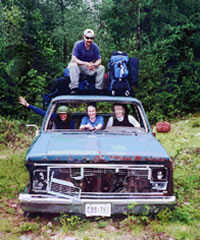 old
logging track, suitable only for heavy-duty bush ATVs or heavy-duty
backpackers. It's rocky, steep, and wet, with slick mud and
huge puddles spanning the full width of the trail that have
to be walked around through the brush or waded through. A
trekking pole (or two) is a big help here. old
logging track, suitable only for heavy-duty bush ATVs or heavy-duty
backpackers. It's rocky, steep, and wet, with slick mud and
huge puddles spanning the full width of the trail that have
to be walked around through the brush or waded through. A
trekking pole (or two) is a big help here.
John, riding shotgun, with Sue, Loretta,
and Gail in Michael Neiger's official backpacker shuttle
wagon (Photo by Loretta Crum)
We camped at the end of our first day on a big outcropping
of rock next to a beaver pond that split in two around us
with a rickety wooden bridge on each end. Sound effects included
peepers, sandhill cranes, loons, mosquitoes, and the occasional
"plonk" of beavers smacking their tails on the water.
Sue, the biologist in our group, pointed out the sound of
a "trilling toad" coming from the pond. I didn't
know that toads trilled.
The second day brought the threat of rain but no rain. We
continued on the logging track until late in the morning when
our guide announced that the bushwhacking part of the trip
would commence shortly.
Michael Neiger's bushwhack routes have become famous (some
would say infamous) among those brave enough to backpack with
him, so we were expecting the worst, but the one-kilometer
cross-country route proved surprisingly gentle: up a steep
hill with plenty of footholds and handholds, around a swamp,
across a soggy beaver dam exactly one hiking boot wide, a
long lunch break in a stand of enormous cedars that filtered
the afternoon sun, and finally down an equally steep hill
to the Little Agawa River where the trees opened up along
a power line with easy walking along a two-track. It had been
an adventure but not an ordeal.
By now it was late afternoon as we dug out our sandals and
waded across the Little Agawa, where Sue and John stopped
for a swim. We went up another hill to the top of a ridge.
Below us the canyon opened up with the Agawa River winding
along the bottom like a ribbon and the railroad tracks looking
small beside it. Michael told us how the river had flooded
up over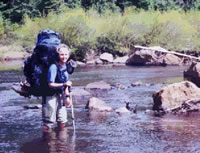 the tracks one spring and the railroad company had to bring
in carloads of iron ore to anchor the bridges so they wouldn't
wash away. Here nature still has the upper hand.
the tracks one spring and the railroad company had to bring
in carloads of iron ore to anchor the bridges so they wouldn't
wash away. Here nature still has the upper hand.
Loretta fords the mighty Little Agawa River
before it drops 600 feet into the Agawa Canyon (Photo by
Loretta Crum)
We tried to camp with the canyon view in sight, but level
ground was in short supply, and the sky was growing ominous.
It rained that evening shortly after dinner so we retired
to our tents, tired anyway. Outdoors at 2:30 a.m., I saw a
sky full of stars; by 3:00 it was raining again and it continued
through the night and into Friday morning.
By the time we had hiked down the south canyon wall along
the power lines and stood on the railroad tracks, the rain
had stopped and we had a dry hike along the rails, watchful
for trains ahead of us and behind. A service truck equipped
with train wheels came blasting around a bend and we dove
for the sides of the tracks in unison with little room to
spare.
Camp that night was on a small 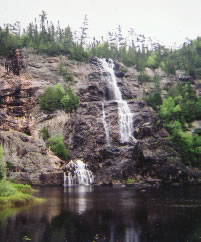 site
between the tracks and the Agawa River just north of Agawa
Canyon Park where two waterfalls--one on each side of the
tracks--cascade down the canyon walls. The park, located on
railroad land-grant property, is the terminus of the tourist
train route and frequently handles 1,500 tourists a day in
the summertime. site
between the tracks and the Agawa River just north of Agawa
Canyon Park where two waterfalls--one on each side of the
tracks--cascade down the canyon walls. The park, located on
railroad land-grant property, is the terminus of the tourist
train route and frequently handles 1,500 tourists a day in
the summertime.
Bridal Veil Falls drops 200 feet over the
east canyon wall into the Agawa River. (Photo by Mary Powell)
The place is absolutely pristine, with no litter anywhere,
and is a textbook study in soft energy: water from a spring
up on the canyon rim is self-pressurized and also provides
a small amount of hydroelectric power for the buildings; propane
powers a series of mantle lights and the water heater; and
toilets for the tourists are the waterless "clivus multrum"
composting type frequently found in remote Canadian tourist
attractions.
Saturday morning we went up the west canyon wall on the Black
Beaver Trail at the south end of the park, which is nearly
vertical in places. The ropes and precarious footing raised
our adrenalin levels and made us pay close attention, but
were a cakewalk compared to the old route--a rickety handmade
ladder made of two-by-fours.
The ACR's Agawa Canyon Station as
viewed from high atop the west canyon wall, looking south
(Photo by Mary Powell)
As we climbed higher, the vegetation changed, and the air
grew cooler. Thick moss and tall fiddlehead ferns sprouted
from cracks in the rocky cliff, and clusters of the biggest
violets I have ever seen grew everywhere. The lushness and
variety reminded me of the temperate rainforests of the Pacific
Northwest and the west coast of New Zealand.
Lunch stop was at Black Beaver Lake, the first and largest
of many jewel-like lakes we would see over the next two days
on the west rim of the canyon. We hiked on the network of
two-tracks that covers this area, mainly used by sportsmen
to reach their camps and lodges.
There are big fish in these lakes; later in the trip a fisherman
would show us a nine-pound brook trout he had caught, nearly
two feet long, red-and-yellow speckles still shining. We were
a curiosity to the fishermen. "Where'd you come from?"
one asked us? When we replied "Frater Station,"
he said, "Ohhhh, so you took the roundabout route."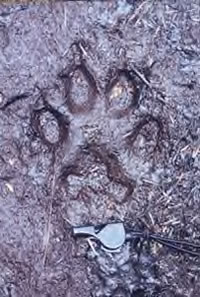
Throughout the trip we had been seeing numerous moose tracks
and occasionally the faint print of a wolf. We weren't lucky
enough to see either animal face to face, but near Black Beaver
Lake we spotted a fresh, perfect wolf track in the mud, following
the tracks of a moose. The print is unmistakable--no dog has
feet that big.
A timber wolf track—with full-size
whistle as a scale—in the mud atop the west canyon
wall (Photo by Loretta Crum)
By now we were down to a core group of seasoned packers and
were covering the miles. We crossed four small streams that
afternoon, three of them without taking off our boots, and
finally made camp in a small gravel pit late in the day, bone
tired. It rained briefly at dinnertime, as it would for the
remainder of the trip, and the black flies had their normal
happy hour.
The beauty of the Canadian spring is not without its price.
The bugs weren't constantly active; they tended to swarm more
during the warmest parts of the day, and the nights were still
too cool for them. Reactions from our group varied, from stoic
refusal to wear a headnet to those who never took theirs off
except to eat.
All of us used bug repellent; John preferred citronella,
adding "Citro-Boy" to his long list of nicknames,
while the rest of us slathered ourselves in deet. For me the
blackflies and mosquitoes (yes, they were there too) were
more a nuisance than a plague, but I could have done without
them. It's not a perfect world.
Sunday was cool and very humid as we hiked an overgrown two-track
back in the direction of the canyon and the tracks. This road
was only shown on a very old map, and Michael pulled out his
compass and counted paces to make sure it was taking us where
we wanted to go. It did, and we were happy to be spared a
long bushwhack. Stopping next to a beaver pond to filter water,
I found a single deep red ladyslipper, much darker than the
pink ones I'm used to seeing in the Upper Peninsula.
Lunch stop was in the front yard of an unused camp on Hotshot
Lake. We stopped and stared when we saw what the owners had
done to keep the bears from breaking in: below each window
and door they had fastened a board full of evil-looking nail
points to keep the animals from standing or leaning too close.
Ingenious, also brutal. Also necessary.
We lounged on the dock in the sun and refilled our water
bottles. Three fishermen--two men and a boy--rowed in closer
to take a look at us. They were firmly wrapped up in headnets
and didn't seem to be enjoying the blackflies much. "Where'd
you come in from?" one of them asked.
By now we knew the drill. "Frater Station."
"By golly, you been all over da place, eh?"
Without missing a beat, Sue spoke up: "Yeah. Like shit
on a wagon wheel."
Inside the headnets, three jaws dropped. The boy looked like
he had finally met some of the people his parents had been
warning him about all his life. The remark did break the ice,
though, and they ended up rowing in closer and talking with
us for a long time.
After that it was on down the trail past several more lakes,
each of them beautiful. The afternoon grew hot. We were hoping
for a campsite in this area, but what little high ground there
was had camps on it. Finally we resigned ourselves to another
long day of hiking and ending up back at the tracks in the
evening. That's part of the adventure, too--you can't always
know what lies up the trail.
Just before the trail descended back down to the canyon,
we came upon a cottage on the prettiest lake yet with a small
island in the middle. The cottage had tiny windows and white
shutters, something straight out of Hansel and Gretel, and
like Hansel and Gretel, we wandered closer.
In the yard a canoe had been sawed off short and turned on
end to make a shrine, and inside the shrine lounged a statue
of a pink pig with a pink bouquet above it. Of course we had
to take pictures of this, and meanwhile the owners came out
on the porch. They were French Canadian, from the Soo, and
very friendly--they even invited us to hike back up the hill
for coffee in the morning.
We exchanged pleasantries and went on. Five minutes later,
bringing up the rear, I heard a motor behind me. The man from
the cottage had followed me on his ATV.
"I take you rest of way," he said in his heavily
accented voice. It wasn't a question.
I debated. He was so nice--it would be rude to say no--and
I wasn't really looking forward to stumbling down the steep
road on a lot of loose rock so late in the day. But it wasn't
going to look good, riding the last quarter mile of the trip
on a four-wheeler.
"My friends will make fun of me if I ride," I told
him.
"Ach, no problem. We take shortcut," he said, jumping
off the machine. The man was at least 70 and agile as a cat.
In short order he had strapped my pack to the frame of the
ATV. "Get on," he ordered.
I got on. The thought crossed my mind that I had survived
five days of heat, bugs, a pack full of pig iron, and a vertical
climb up a cliff, only to be killed by a senior citizen driving
a four-wheeler, but the guy turned out to be a superb driver.
The machine was fully equipped for the bush--hefty four-wheel-drive
thing with steel racks overhead for carrying gear and possibly
to serve as a roll cage; winch; axe fastened to the front.
He turned off the trail and onto a muddy track through the
woods that went straight up. The machine stalled out on the
hill in the mud. "I back up," he said, threw it
in reverse, and took another run at the hill. This time we
made it and went careening down the other side.
The shortcut turned out to be a ploy--it did not bypass my
friends. We burst out of the woods straight into the middle
of my fellow trekkers, who wisely chose to scatter. "I
come back for them after I take you down," my escort
said. I was trying to picture this as we roared past Michael,
who stared at me. Obviously he did not approve of his trekkers
cadging ATV rides from the locals.
The guy probably would have taken all five of us down, one
at a time, if dinner hour hadn't intervened. At 5:00 it was
like someone (namely his wife) had thrown a switch and off
he went, promising to return in the morning. Before he left
he showed us a sandbar on the Agawa River where he said there
were trout. Most of us swam there, one at a time. The water
was cold but absolutely pure; I let out a whoop as I plunged
in and afterward I felt baptized.
Dinner brought the usual rain and bugs as we camped next
to the tracks at Mile 118.5. After it cleared up we emerged
from our tents and stayed up to talk and make the final night
of the trip last. The last thing I heard as I fell asleep
was the hooting of a barred owl ("whoo-cooks-for-yoooo"),
probably chasing a certain member of our group who felt the
sudden urge to step out into the dark and howl and hoot before
bedtime.
Monday morning it was hurry up and wait for the train. Mary
and Mara, who had been walking the tracks all weekend, rejoined
us. We swatted bugs, chatted with the half dozen or so fishermen
who emerged from the woods on ATVs, and tried to make Gail
reveal the contents of her trip journal, to no avail.
The train came at 2:30, only an hour late. We boarded and
wandered back to the rear car to look out from the platform
at the places we had walked as the engine curved and climbed
the sixteen miles back to Frater. From the top of the canyon
wall we looked down through a notch in the hills to Lake Superior
and Montreal Island laid out before us in the distance while
the Agawa River glistened in the canyon below. I vowed to
come back in the fall.
There are trips, and then there is travel. Trips are always
a pleasure, but they don't take me far away enough. Travel
is magical--it lasts long enough to make the world I came
from seem unreal, and it's the result of forces beyond my
control 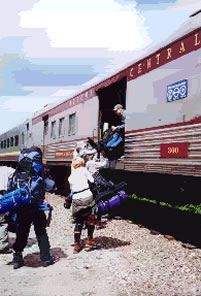 coming
together. Everything came together for this trip--the places,
the people we met along the way, the moments of silence interspersed
with times of raucous laughter. There was a little danger
for spice, a touch of drudgery so I'd appreciate the high
points,and a constant sense of adventure around the next bend
in the trail. Agawa is that kind of place. coming
together. Everything came together for this trip--the places,
the people we met along the way, the moments of silence interspersed
with times of raucous laughter. There was a little danger
for spice, a touch of drudgery so I'd appreciate the high
points,and a constant sense of adventure around the next bend
in the trail. Agawa is that kind of place.
En route back to their vehicles at the
long-abandoned Algoma Central Railway Frater Station, Mara
and Mary hoist their rucksacks into the ACR No.2 baggage
car in the Canyon (Photo by Loretta Crum)
Read another journal...
|


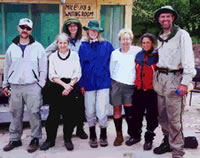
 old
logging track, suitable only for heavy-duty bush ATVs or heavy-duty
backpackers. It's rocky, steep, and wet, with slick mud and
huge puddles spanning the full width of the trail that have
to be walked around through the brush or waded through. A
trekking pole (or two) is a big help here.
old
logging track, suitable only for heavy-duty bush ATVs or heavy-duty
backpackers. It's rocky, steep, and wet, with slick mud and
huge puddles spanning the full width of the trail that have
to be walked around through the brush or waded through. A
trekking pole (or two) is a big help here.  the tracks one spring and the railroad company had to bring
in carloads of iron ore to anchor the bridges so they wouldn't
wash away. Here nature still has the upper hand.
the tracks one spring and the railroad company had to bring
in carloads of iron ore to anchor the bridges so they wouldn't
wash away. Here nature still has the upper hand. site
between the tracks and the Agawa River just north of Agawa
Canyon Park where two waterfalls--one on each side of the
tracks--cascade down the canyon walls. The park, located on
railroad land-grant property, is the terminus of the tourist
train route and frequently handles 1,500 tourists a day in
the summertime.
site
between the tracks and the Agawa River just north of Agawa
Canyon Park where two waterfalls--one on each side of the
tracks--cascade down the canyon walls. The park, located on
railroad land-grant property, is the terminus of the tourist
train route and frequently handles 1,500 tourists a day in
the summertime.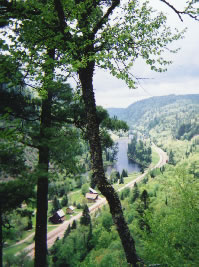

 coming
together. Everything came together for this trip--the places,
the people we met along the way, the moments of silence interspersed
with times of raucous laughter. There was a little danger
for spice, a touch of drudgery so I'd appreciate the high
points,and a constant sense of adventure around the next bend
in the trail. Agawa is that kind of place.
coming
together. Everything came together for this trip--the places,
the people we met along the way, the moments of silence interspersed
with times of raucous laughter. There was a little danger
for spice, a touch of drudgery so I'd appreciate the high
points,and a constant sense of adventure around the next bend
in the trail. Agawa is that kind of place.